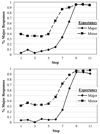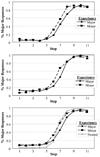Context effects on musical chord categorization: Different forms of top-down feedback in speech and music?
- PMID: 21490878
- PMCID: PMC3073321
- DOI: 10.1080/03640210802222021
Context effects on musical chord categorization: Different forms of top-down feedback in speech and music?
Abstract
A critical issue in perception is the manner in which top-down expectancies guide lower-level perceptual processes. In speech, a common paradigm is to construct continua ranging between two phonetic endpoints and to determine how higher level lexical context influences the perceived boundary. We applied this approach to music, presenting subjects with major/minor triad continua after brief musical contexts. Two experiments yielded results that differed from classic results in speech perception. In speech, context generally expands the category of the expected stimuli. We found the opposite in music: the major/minor boundary shifted toward the expected category, contracting it. Together, these experiments support the hypothesis that musical expectancy can feed back to affect lower-level perceptual processes. However, it may do so in a way that differs fundamentally from what has been seen in other domains.
Figures








Similar articles
-
The neural bases of the lexical effect: an fMRI investigation.Cereb Cortex. 2008 Feb;18(2):278-88. doi: 10.1093/cercor/bhm053. Epub 2007 May 15. Cereb Cortex. 2008. PMID: 17504782
-
Rhythmic Effects of Syntax Processing in Music and Language.Front Psychol. 2015 Nov 23;6:1762. doi: 10.3389/fpsyg.2015.01762. eCollection 2015. Front Psychol. 2015. PMID: 26635672 Free PMC article.
-
Natural music context biases musical instrument categorization.Atten Percept Psychophys. 2020 Jul;82(5):2209-2214. doi: 10.3758/s13414-020-01980-w. Atten Percept Psychophys. 2020. PMID: 32077070
-
Can nonlinguistic musical training change the way the brain processes speech? The expanded OPERA hypothesis.Hear Res. 2014 Feb;308:98-108. doi: 10.1016/j.heares.2013.08.011. Epub 2013 Sep 20. Hear Res. 2014. PMID: 24055761 Review.
-
Influence of musical expertise and musical training on pitch processing in music and language.Restor Neurol Neurosci. 2007;25(3-4):399-410. Restor Neurol Neurosci. 2007. PMID: 17943015 Review.
Cited by
-
Analyzing the User Behavior toward Electronic Commerce Stimuli.Front Behav Neurosci. 2016 Nov 30;10:224. doi: 10.3389/fnbeh.2016.00224. eCollection 2016. Front Behav Neurosci. 2016. PMID: 27965549 Free PMC article.
-
Lexical Influences on Categorical Speech Perception Are Driven by a Temporoparietal Circuit.J Cogn Neurosci. 2021 Apr 1;33(5):840-852. doi: 10.1162/jocn_a_01678. J Cogn Neurosci. 2021. PMID: 34449838 Free PMC article.
-
Impaired categorical perception of lexical tones in Mandarin-speaking congenital amusics.Mem Cognit. 2012 Oct;40(7):1109-21. doi: 10.3758/s13421-012-0208-2. Mem Cognit. 2012. PMID: 22549878
-
What information is necessary for speech categorization? Harnessing variability in the speech signal by integrating cues computed relative to expectations.Psychol Rev. 2011 Apr;118(2):219-46. doi: 10.1037/a0022325. Psychol Rev. 2011. PMID: 21417542 Free PMC article.
References
-
- Arao H, Gyoba J. Disruptive effects in chord priming. Music Perception. 1999;17(2):241–255.
-
- Besson M, Schön D. Comparison between language and music. Annals of the New York Academy of Sciences. 2001;930:232–258. - PubMed
-
- Bharucha JJ. Music cognition and perceptual facilitation: A connectionist framework. Music Perception. 1987;5:1–30.
-
- Bharucha J, Stoeckig K. Reaction time and musical expectancy: priming of chords. Journal of Experimental Psychology: Human Perception and Performance. 1986;12(4):403–410. - PubMed
-
- Bharucha JJ, Stoeckig K. Priming of chords: Spreading activation or overlapping frequency spectra? Perception & Psychophysics. 1987;41(6):519–524. - PubMed
Grants and funding
LinkOut - more resources
Full Text Sources

